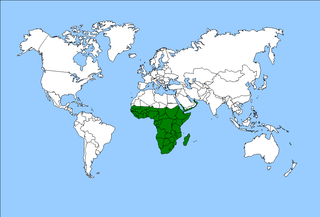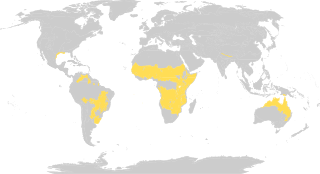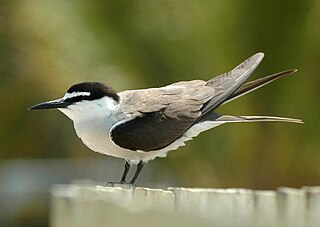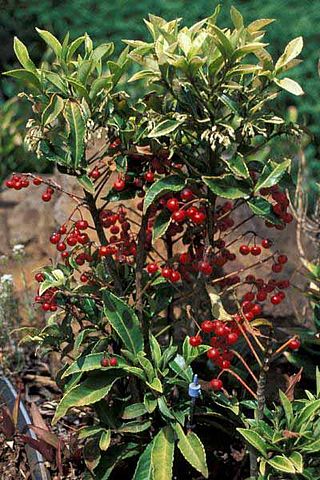
The Afrotropical realm is one of the Earth's eight biogeographic realms. It includes Sub-Saharan Africa, the southern Arabian Peninsula, the island of Madagascar, and the islands of the western Indian Ocean. It was formerly known as the Ethiopian Zone or Ethiopian Region.

Tropical and subtropical grasslands, savannas, and shrublands is a terrestrial biome defined by the World Wide Fund for Nature. The biome is dominated by grass and/or shrubs located in semi-arid to semi-humid climate regions of subtropical and tropical latitudes. Tropical grasslands are mainly found between 5 degrees and 20 degrees in both North and south of the Equator.

Tropical and subtropical moist broadleaf forests (TSMF), also known as tropical moist forest, is a subtropical and tropical forest habitat type defined by the World Wide Fund for Nature.

The blue-cheeked bee-eater is a near passerine bird in the bee-eater family, Meropidae. The genus name Merops is Ancient Greek for "bee-eater", and persicus is Latin for "Persian".

The bridled tern is a seabird of the family Laridae. It is a bird of the tropical oceans. The scientific name is from Ancient Greek. The genus comes from onux meaning "claw" or "nail", and prion, meaning "saw". The specific anaethetus means "senseless, stupid".

Delonix regia is a species of flowering plant in the bean family Fabaceae, subfamily Caesalpinioideae native to Madagascar. It is noted for its fern-like leaves and flamboyant display of orange-red flowers over summer. In many tropical parts of the world it is grown as an ornamental tree and in English it is given the name royal poinciana, flamboyant, phoenix flower, flame of the forest, or flame tree.

Myrsinoideae is a subfamily of the family Primulaceae in the order Ericales. It was formerly recognized as the family Myrsinaceae, or the myrsine family, consisting of 35 genera and about 1000 species. It is widespread in temperate to tropical climates extending north to Europe, Siberia, Japan, Mexico, and Florida, and south to New Zealand, South America, and South Africa.

Terminalia catappa is a large tropical tree in the leadwood tree family, Combretaceae, native to Asia, Australia, the Pacific, Madagascar and Seychelles. Common names in English include country almond, Indian almond, Malabar almond, sea almond, tropical almond, beach almond and false kamani.

Kigelia is a genus of flowering plants in the family Bignoniaceae. The genus consists of only one species, Kigelia africana, which occurs throughout tropical Africa. The so-called sausage tree grows a poisonous fruit that is up to 60 cm long, weighs about 7 kg, and resembles a sausage in a casing.

The West African oyan, also known as the West African linsang, is a linsang species native to the Upper Guinean forests in West Africa. It is one of the least known small carnivores in Africa.

The flat-headed kusimanse is a mongoose species endemic to West African rainforests. It is listed as Least Concern on the IUCN Red List since 2008.

Bates's pygmy antelope, also known as the dwarf antelope, pygmy antelope or Bates' dwarf antelope, is a very small antelope living in the moist forest and brush of Central and West Africa. It is in the same genus as the suni.
Guibourtia ehie is an evergreen tree of the genus Guibourtia in the family Fabaceae, also known by the common names amazique, amazoué, hyedua, black hyedua, mozambique, ovangkol and shedua.

Monodora myristica, the calabash nutmeg or African nutmeg, is a tropical tree of the family Annonaceae or custard apple family of flowering plants. It is native to tropical Africa from Sierra Leone in the west to Tanzania. In former times, its seeds were widely sold as an inexpensive nutmeg substitute. This is now less common outside its region of production. Other names of calabash nutmeg include Jamaican nutmeg, ehuru, ariwo, awerewa, ehiri, airama, African orchid nutmeg, muscadier de Calabash and lubushi.

Alsodeiopsis Oliver is a genus of plants in the family Icacinaceae native to tropical Africa. There are about 11 species. Seventeen species names have been published in Alsodeiopsis, but many of these are synonyms. The type species, Alsodeiopsis mannii was named by Daniel Oliver in 1869.

Embelia is a genus of climbing shrubs once placed in the family Myrsinaceae, which is now included in the Primulaceae. There are about 130 species which occur in tropical and subtropical areas across a wide range including Africa and Madagascar and from eastern Asia to the Pacific Islands as well as Australia including:

Euphorbia rowlandii, the Levuvhu euphorbia, is a succulent member of the spurge family native to the Soutpansberg region in South Africa, and southeastern Zimbabwe. It is a medium-sized, monoecious shrub with multiple spiny blue-green photosynthetic stems. The species is superficially similar to E. waterbergensis, and is named after the Levubu River.
Erythrophleum ivorense is a species of leguminous tree in the genus Erythrophleum found in the rainforests of tropical West and Central Africa. The tree has many uses; the timber is used for heavy construction, for making charcoal and for firewood, the bark is used for tanning and in traditional medicine, and both bark and seeds are poisonous and used for hunting.
Daniellia oliveri is a species of tree in the family Fabaceae. It is native to tropical West and Central Africa and is commonly known as the African copaiba balsam tree, or the West African copal tree.
Embelia schimperi is a shrubby climber or small tree within the family Primulaceae.















